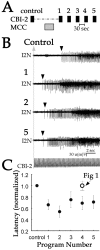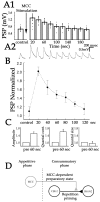Convergent mechanisms mediate preparatory states and repetition priming in the feeding network of Aplysia
- PMID: 12764089
- PMCID: PMC6741109
- DOI: 10.1523/JNEUROSCI.23-10-04029.2003
Convergent mechanisms mediate preparatory states and repetition priming in the feeding network of Aplysia
Abstract
Improvement of behavioral responses to expected stimuli has been attributed to a change in the preparatory state. In this study, we take advantage of the accessibility of the nervous system of Aplysia and develop an in vitro analog of the preparatory state for feeding behaviors. We provide evidence that the change in the preparatory state may be elicited initially by activity of identified serotonergic metacerebral cells (MCCs). We demonstrate, however, that the preparatory state is maintained through MCC-independent repetition priming that is embedded in the properties of the behavior-generating network. Both MCC-dependent and MCC-independent processes converge on the same site in the behavior-generating network to mediate the change in the preparatory state. Thus, we propose a model of how multiple neuronal structures interact to elicit and maintain changes in the preparatory states in the CNS.
Figures




Similar articles
-
The role of interneurons in controlling the tail-withdrawal reflex in Aplysia: a network model.J Neurophysiol. 1993 Nov;70(5):1777-86. doi: 10.1152/jn.1993.70.5.1777. J Neurophysiol. 1993. PMID: 8294952
-
Sensitization of the gill and siphon withdrawal reflex of Aplysia: multiple sites of change in the neuronal network.J Neurophysiol. 1993 Sep;70(3):1210-20. doi: 10.1152/jn.1993.70.3.1210. J Neurophysiol. 1993. PMID: 8229169
-
A specific synaptic pathway activates a conditional plateau potential underlying protraction phase in the Aplysia feeding central pattern generator.J Neurosci. 2004 Jun 2;24(22):5230-8. doi: 10.1523/JNEUROSCI.5649-03.2004. J Neurosci. 2004. PMID: 15175393 Free PMC article.
-
Behavioral switching of biting and of directed head turning in Aplysia: explorations using neural network models.Acta Biol Hung. 1992;43(1-4):315-28. Acta Biol Hung. 1992. PMID: 1299121 Review. No abstract available.
-
Postsynaptic regulation of the development and long-term plasticity of Aplysia sensorimotor synapses in cell culture.J Neurobiol. 1994 Jun;25(6):666-93. doi: 10.1002/neu.480250608. J Neurobiol. 1994. PMID: 8071666 Review.
Cited by
-
Intrinsic and Extrinsic Neuromodulation of Olfactory Processing.Front Cell Neurosci. 2018 Jan 9;11:424. doi: 10.3389/fncel.2017.00424. eCollection 2017. Front Cell Neurosci. 2018. PMID: 29375314 Free PMC article. Review.
-
Molecular signaling involved in regulating feeding and other motivated behaviors.Mol Neurobiol. 2007 Feb;35(1):1-20. doi: 10.1007/BF02700621. Mol Neurobiol. 2007. PMID: 17519503 Review.
-
Removal of default state-associated inhibition during repetition priming improves response articulation.J Neurosci. 2012 Dec 5;32(49):17740-52. doi: 10.1523/JNEUROSCI.4137-12.2012. J Neurosci. 2012. PMID: 23223294 Free PMC article.
-
Neural analog of arousal: persistent conditional activation of a feeding modulator by serotonergic initiators of locomotion.J Neurosci. 2008 Nov 19;28(47):12349-61. doi: 10.1523/JNEUROSCI.3855-08.2008. J Neurosci. 2008. PMID: 19020028 Free PMC article.
-
Repetition priming of motor activity mediated by a central pattern generator: the importance of extrinsic vs. intrinsic program initiators.J Neurophysiol. 2016 Oct 1;116(4):1821-1830. doi: 10.1152/jn.00365.2016. Epub 2016 Jul 27. J Neurophysiol. 2016. PMID: 27466134 Free PMC article.
References
-
- Aston-Jones G, Rajkowski J, Cohen J ( 1999) Role of locus coeruleus in attention and behavioral flexibility. Biol Psychiatry 46: 1309–1320. - PubMed
-
- Church PJ, Lloyd PE ( 1994) Activity of multiple identified motor neurons recorded intracellularly during evoked feedinglike motor programs in Aplysia J Neurophysiol 72: 1794–1809. - PubMed
-
- Connolly JD, Goodale MA, Menon RS, Munoz DP ( 2002) Human fMRI evidence for the neural correlates of preparatory set. Nat Neurosci 5: 1345–1352. - PubMed
Publication types
MeSH terms
Substances
Grants and funding
LinkOut - more resources
Full Text Sources
